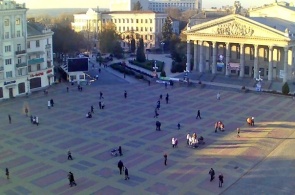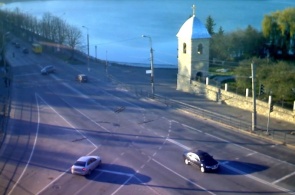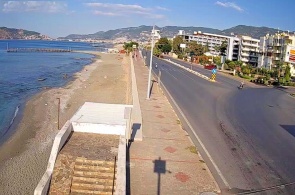One of the largest historical centers in the WesternUkraineisTernopil– a town situated on the banks of the Seret river. Wonderful atmosphere, ancient buildings, superb Western-Ukrainian culture, will give a sense of comfort and peace to all who want to visit Ternopil. The city's large number of attractions that came to us from time immemorial, and modern cultural values and works of art. Get to know this city needs slowly. And, of course – clearly Ternopil will open to those who are familiar with his story. The first mention of the then city of Tarnopol, date back to 1540, the year when the Krakow castellan Jan Tarnowski was granted Royal Charter with seal of Sigismund I, in which the tycoon was given the right for the construction of the castle in the tract Sopilche, the establishment of the new city and the management of adjacent lands, protecting the South-Eastern frontiers of the Polish state against Tatar attacks. But fertile land and dense forests served as a refuge from enemies, people were attracted to this land much earlier. This is evidenced by numerous archaeological finds. Ternopil construction of the fortress took eight years. In the fortification system of the citadel consisted of three tower defense, castle, synagogue, and Church of the Nativity and exaltation of the cross (nadstavna) temple, which survived until our days. Despite the rare visits of the head of the Ternopil – then the city grew rapidly, and by the closing date of the construction of the Ternopil castle received the Magdeburg law, which gives residents a host of privileges, which contributed to even more rapid growth of the population and the economy of the city. Ternopil has a notable history of various military battles and national liberation struggles. During its existence, the city was repeatedly plundered by Tatars and Turks burned and destroyed, many times repulsed the attacks, residents of the city, kept the defense, not yield before the onslaught of the enemy. Here was held the liberating path of Bogdan Khmelnitsky against Polish oppression. During world war II Ternopil was occupied by the Nazis, almost all the way to the Victory. In these troubled times, the city was almost completely destroyed, and was destroyed the jewel of the Ternopil – ancient city pond. After the war, the pond has been fully restored to 1956. Adjacent to the lake territories were carried out voluntary activities on the improvement, and was also laid hugePark them. T. G. Shevchenkothat is one of the favorite places for walking residents and visitors.
More details
Webcam shows a view of the Theater square in Ternopil (Ukraine). This wide Boulevard, with beautiful monuments and unusual landscaping. The area is located in the centre of the city. Here is the Regional academic music and drama theatre. T. G. Shevchenko.
Ternopil, Ukraine
15.04.15
The camera shows a view of the intersection of them. Anatoly Zhivov and Metropolitan Andrey Sheptytsky, in the city of Ternopil. Here is a publishing and printing center "Zbruch", named after the river which flows at the borders of Ternopil and Khmelnytsky regions in Ukraine. Also, the intersection is a small market, two shopping complex and bus stop.
Ternopil, Ukraine
15.04.15
The camera shows the bridge over the pond in Ternopil, located in the Park of T. G. Shevchenko, in the city of Ternopil. At the time when the Ternopil castle, the water of the river Seret, which was created by the artificial lake, filled the moat of the fortress walls, and carried many economic functions for the population. In 1987, the Park has gained worldwide significance after the implementation of the world competitions vodomotornomu sport.
Ternopil, Ukraine
15.04.15
One of the most beautiful parks of Ternopil is the hotel. T. G. Shevchenko. There is a wide embankment at the pond formed from the overlap of the river Seret, a large number of green spaces, bridges, and "Island of love" with Grecian temple, near which is located the webcam.
Ternopil, Ukraine
15.04.15
The web camera shows the concert hall under the open sky, situated in the Park of the national revival of the city of Ternopol (Ukraine). There are various contests and song festivals. The stage is an open stage has special acoustics, which plays an important role in ensuring quality sound during the performances.
Ternopil, Ukraine
15.04.15
Theatre square is a beautiful and amazing decoration of Ternopil, which leaves one of the cameras of our site to You first without even leaving Your home or office, able to see with this colorful area is small but not provincial town Ternopil.
Ternopil, Ukraine
24.11.14
The camera opens on a monument to the leader of the Ukrainian nationalist movement OUN – Stepan Bandera, located in the centre paved with paving slabs, the square green geometric flower beds, conifer trees and shrubs.
Ternopil, Ukraine
24.11.14
popular camerasshow all
Sultanahmet or Blue mosque is a work of art of Turkish-Islamic architecture. Its construction began in 1609, the construction work took seven years to a 19-year-old Sultan. The name of the mosque was, due to its interesting and unique finish.
Istanbul, Turkey
08.02.14
Stavanger, a town in the commune of Norway, located in the South-Western part of the country, on the Peninsula, rich in minerals. Tanager combines the influence of foreign organisations such as NATO and oil companies. The camera will shoot the harbour and the promenade of the city.
Stavanger, Norway
03.11.13
A webcam broadcasts the district of Tosmur - quiet location in the Eastern part of Alanya, located only five kilometres from the city centre. Its rural way of life and the beauty of untouched nature attract tourists.
Alanya, Turkey
10.11.18
Shark Island or in English of Shark island, located in the harbour city of Sydney, the suburb of Point Piper. The locals, the natives named the island Boambilly, which translated means Shark island. After all, this name is not casual, because it's mean and looks like a shark fin.
Sydney, Australia
31.10.13
The webcam is installed on site Alva. Tsaghkadzor ski resort town in Armenia. Tsaghkadzor is a beautiful mountainous area among deciduous forests, with a pleasant winter climate, and clean fresh air. The highest point is 1800 meters. The truss type is a classic, divided into three.
Tsakhkadzor, Armenia
18.01.14














